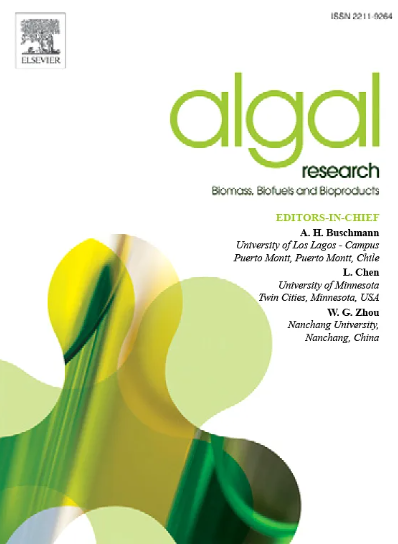Integrated approach for wastewater remediation and biofertilizer development using Chlorella vulgaris in raceway ponds
IF 4.6
2区 生物学
Q1 BIOTECHNOLOGY & APPLIED MICROBIOLOGY
Algal Research-Biomass Biofuels and Bioproducts
Pub Date : 2025-03-31
DOI:10.1016/j.algal.2025.104022
引用次数: 0
Abstract
Wastewater is quite complex and requires a series of different processes for its treatment. Vermifilters are one such strategy that significantly reduces pollutants but with limited ability to remove phosphorus and nitrogen. To address this, the effluent from the vermifilters can be further processed by microalgae, which can enhance water quality. In this study, microalgae were cultivated in an outdoor raceway pond, using treated wastewater as medium, and the resulting biomass was used as a biofertilizer for Cherry tomato (Solanum lycopersicum var. cerasiforme) cultivation. The microalgae treatment led to significant reductions of 78 % in COD, 86 % in phosphorus, and 45 % in nitrogen (p < 0.05). A microalgae concentration of 1.45 g/L was achieved, with a productivity rate of 0.43 g/L/day. The microalgae biomass contained 56.17 % protein, 30.73 % carbohydrates, and 18 % lipids. After 90 days of growth, cherry tomato plants fertilized with the microalgae-based biofertilizer produced a total weight of 622.4 g, compared to 756.5 g with chemical NPK fertilizer (20-20-20) and 285.4 g with no fertilizer (the control). In terms of other growth metrics such as average height, dry biomass, and number of leaves; the plants treated with commercial fertilizer reached the best results, following by the microalgae biofertilizer and finally, the control showed the least growth. These results suggest that microalgae-based biofertilizer can be a promising alternative, particularly for sandy loam soils, which are usually employed for tomato cultivation.

利用小球藻开发污水修复与生物肥料的综合方法
废水是非常复杂的,需要一系列不同的工艺来处理。蚯蚓过滤器就是这样一种策略,它可以显著减少污染物,但去除磷和氮的能力有限。为了解决这个问题,微藻可以进一步处理从过滤器流出的污水,从而提高水质。本研究以处理后的废水为培养基,在室外沟道池中培养微藻,所得生物量作为樱桃番茄(Solanum lycopersicum var. cerasiformme)的生物肥料。微藻处理导致COD显著降低78%,磷降低86%,氮降低45% (p <;0.05)。微藻浓度为1.45 g/L,产率为0.43 g/L/d。微藻生物量中蛋白质含量为56.17%,碳水化合物含量为30.73%,脂类含量为18%。生长90天后,施用微藻生物肥料的樱桃番茄植株总重为622.4 g,而施用化学氮磷钾(20-20-20)和不施肥(对照)的樱桃番茄植株总重分别为756.5 g和285.4 g。在其他生长指标方面,如平均高度、干生物量和叶片数量;施用商品肥料的植株生长效果最好,施用微藻生物肥料次之,最后施用对照植株生长效果最差。这些结果表明,以微藻为基础的生物肥料可能是一种很有前途的替代方案,特别是对于通常用于番茄种植的沙质壤土。
本文章由计算机程序翻译,如有差异,请以英文原文为准。
求助全文
约1分钟内获得全文
求助全文
来源期刊

Algal Research-Biomass Biofuels and Bioproducts
BIOTECHNOLOGY & APPLIED MICROBIOLOGY-
CiteScore
9.40
自引率
7.80%
发文量
332
期刊介绍:
Algal Research is an international phycology journal covering all areas of emerging technologies in algae biology, biomass production, cultivation, harvesting, extraction, bioproducts, biorefinery, engineering, and econometrics. Algae is defined to include cyanobacteria, microalgae, and protists and symbionts of interest in biotechnology. The journal publishes original research and reviews for the following scope: algal biology, including but not exclusive to: phylogeny, biodiversity, molecular traits, metabolic regulation, and genetic engineering, algal cultivation, e.g. phototrophic systems, heterotrophic systems, and mixotrophic systems, algal harvesting and extraction systems, biotechnology to convert algal biomass and components into biofuels and bioproducts, e.g., nutraceuticals, pharmaceuticals, animal feed, plastics, etc. algal products and their economic assessment
 求助内容:
求助内容: 应助结果提醒方式:
应助结果提醒方式:


